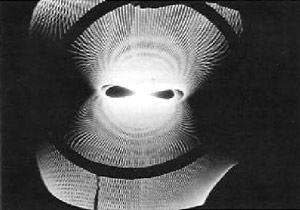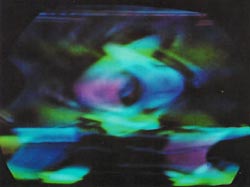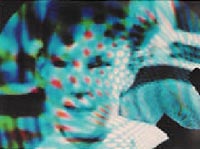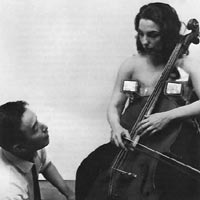[ index | VIDEO | 1970 ]
Nam June Paik: Cathode Karma
(cf. also: Nam June Paik - various articles)
"Cybernetics, the art of pure relations, has its origins in karma. The Buddhists say karma is sangsara, relationship is metempsychosis. Cybernated art is important, but art for cybernated life is more important, and the latter need not be cybernated."
"My experimental television is not always interesting," admits Nam June Paik, "but not always uninteresting: like nature, which is beautiful not because it changes beautifully, but simply because it changes." Paik is the embodiment of East and West, design scientist of the electron gun, pioneer ecologist of the videosphere. He is to television what John Whitney is to the computer; he does with TV sets what David Tudor does with pianos. "Television has been attacking us all our lives," he says, "now we can attack it back."
This Korean-born genius has been attacking it back longer than anyone, and in his own inimitable fashion. The bloody head of an ox was hung over the door to his first video exhibit in Wuppertal, Germany, in 1963, as a shock device "to get the audience into a oneness of consciousness so they could perceive more" - as in Zen, the master would strike the pupil. Although he never really harmed anyone, Paik was for several years a cultural terrorist, a kind of deus ex machina of the Orient, who left in his wake a series of demolished pianos, clipped neckties, bizarre junkyard robots, and scandalized audiences from Holland to Iceland. John Cage once remarked that "Paik's work, performances, and daily doings never cease by turn to amaze, delight, shock, and sometimes terrify me."
In recent years Paik has abandoned his mixed-media environmental Happenings to concentrate exclusively on television as an aesthetic and communicative instrument. Independently, in collaboration with scientists, and in a special research and development program with the State University of New York, he has explored nearly every facet of the medium, paving the way for a new generation of video artists. His work has followed four simultaneous directions: synaesthetic videotapes; videotronic distortions of the received signal; closed-circuit teledynamic environments; and sculptural pieces, usually of a satirical nature.
There are approximately four million individual phosphor tracepoints on the face of a 21-inch television screen at any given moment. Paik's canvas is the electromagnetic field that controls the distribution of these trace-points in horizontal and vertical polar coordinates at 525 lines per second. By interfering, warping, and otherwise controlling the cathode's magnetic field, he controls the four million glowing traces. "It creates the possibility of electrondrawing," he says. "It's better than drawing on a CRT with a light pen because it's multicolored and provides interaction with the air program."
Although he is continually developing new parameters of control and interaction with television, most of Paik's basic techniques were developed in the period 1963-64 in collaboration with Hideo Uchida, president of Uchida Radio Research Institute in Tokyo, and with Shuya Abe, an electronics engineer who, according to Paik, "knows that science is more beauty than logic." Paik has outlined three general areas of variability with these techniques. ("Indeterminism and variability are underdeveloped parameters in the optical arts," he says, "though they have been the central problem in music for the last two decades. Conversely, the parameter of sex has been underdeveloped in music as opposed to literature and the visual arts.")
The first level of variability is the live transmission of the normal broadcast program, "which is the most variable optical and semantical event of our times... the beauty of distorted Nixon is different from the beauty of distorted football hero, or not always pretty but always stupid female announcer." Paik estimates that he can create at least five hundred different variations from one normal broadcast program.
The second level of variability involves the unique characteristics of circuitry in each individual television receiver. Paik has resurrected several dozen discarded sets from junkyards and brought them back to wilder life than ever before in their previous circuits. "I am proud to say that thirteen sets suffer thirteen different varieties of distortion," Paik once announced, and then added: "1957 model RCA sets are the best." By altering the circuitry of his receivers with resistors, interceptors, oscillators, grids, etc., Paik creates "prepared televisions" that are equivalent in concept to David Tudor's prepared pianos.

The third level of variability is the manipulation of these prepared TVs with wave-form generators, amplifiers, and tape recorders to produce various random, semirandom, or completely controlled effects, examples of which are: (a) the picture is changeable in three ways using hand switches: upside-down, right-left, positive-negative; (b) the picture can become smaller or larger in vertical or horizontal dimensions separately, according to the amplitude of the tape recorder; (c) the horizontal and vertical electron-beam deflection of normal TV is changed into a spiral deflection using a yoke oscillatoramplifier, causing an average rectangular picture to become fanlike; (d) the picture can be "dissipated" by a strong demagnetizer whose location and rhythm contribute variety; (e) amplitude levels from radios or tape recorders can be made to intercept a relay signal at the grid of the output tube so that the picture is visible only when the amplitude changes; (f) asymmetrical sparks flash across the screen when a relay is intercepted at the AC 110-volt input and fed by a 25- watt amplifier without rectifier; (g) a 10-megohm resistor is placed at the vertical grid of the output tube and interacts with a sine wave to modulate the picture; (h) wave forms from a tape recorder are fed to the horizontal grid of the output tube, causing the horizontal lines to be warped according to the frequency and amplitude.

Once a set has been thus prepared, the simple flick of a switch results in breathtakingly beautiful imagery, from delicate Lissajous figures to spiraling phantasmagoric designs of surreal impact and dazzling brilliance. Tubular horizontal bands of color roll languidly toward the viewer like cresting waves; flaccid faces melt, twitch, and curl, ears replacing eyes; globs of iridescent colors flutter out of place. When videotape playback systems are used as image sources instead of broadcast programs, the extent of control is multiplied and the visual results are astounding.
However, technical descriptions tend to underplay the sheer intuitive genius of Paik's video art. His techniques are hardly exclusive and are far from sophisticated (engineers say he does everything he shouldn't), and his cluttered loft on New York's Canal Street is scientifically unorthodox to say the least. Yet out of this tangle of wires and boxes comes some of the most exquisite kinaesthetic imagery in all of electronic art. "My experimental color television has instructional resource value," he suggests. “Kindergarten and elementary school children should be exposed to electronic situations as early as possible. My experimental TV demonstrates various basic facts of physics and electronics empirically, such as amplitude modulation, radar, scanning, cathode rays, shadow mask tubes, oscillography, the ohm principle, overtone, magnetic character, etc. And it's a very pleasant way to learn these things."
Perhaps the most spectacular of Paik's videotape compositions was made early in 1969 for the PBL show "The Medium Is the Medium" at WGBH-TV in Boston, where later he became artist in residence. Paik brought a dozen of his prepared TVs into the studio; using three color cameras he mixed these images with two nude dancers, tape delays, and positive-negative image reversals. The nude slow-motion dancers in multiple levels of delayed action suddenly burst into dazzling silver sparks against emerald gaseous clouds; rainbow-hued Lissajous figures revolved placidly over a close-up of two lovers kissing in negative colors; images of Richard Nixon and other personalities in warped perspectives alternated with equally warped hippies. All this was set against a recording of the Moonlight Sonata, interrupted periodically by a laconic Paik who yawned, announced that life was boring, and instructed the viewer to close his eyes just as some fabulous visual miracle was about to burst across the screen.
Later in 1969, Paik produced an impressive teledynamic environment called Participation TV. The first version was shown in an exhibit called "Television as a Creative Medium" at the Howard Wise Gallery in New York City; it was then modified into Participation TV No. 2 for the "Cybernetic Serendipity" exhibit in Washington, D.C. The principle of the piece involves three television cameras whose signals are displayed on one screen by the red, green, and blue cathode guns respectively; the tube shows three different images in three different colors at once. Color brightness is controlled by amplitudes from three tape recorders at reverse phase. Thus the viewer sees himself three times in three colors on the same screen, often appearing to float in air or to dissolve in shimmering water as multicolored feedback echoes shatter into infinity. This was repeated on three and four different TV sets arranged around the environment.

"The real issue implied in art and technology," he has said, "is not to make another scientific toy, but how to humanize the technology and the electronic medium… I suggest Silent TV Station, which transmits only beautiful 'mood art' in the sense of mood music. What I'm aiming at with my Lissajous figures and other distortions is a television equivalent of Vivaldi, or electronic Compoz. Lumia art will then become a permanent asset in the collections of millions of people. The Silent TV Station will simply be there, not intruding on other activities, and will be looked at exactly like a landscape or a beautiful bathing nude of Renoir. Normal TV bores you and makes you nervous; this soothes you. It's like a tranquilizer. Maybe you could call it video-soma."

Paik's exquisite sense of satirical irony comes through most effectively in his video sculpture pieces. In TV Bra for Living Sculpture, Paik covered cellist Charlotte Moorman's bare breasts with two tiny three-inch TV sets whose images were modulated by the notes played on her cello. "Another attempt to humanize technology," Paik explained. For an exhibit titled "The Machine at the End of the Machine Age" at the Museum of Modern Art, Paik contributed a chair with a built-in TV set in place of the seat: one was able to sit on the program of one's choice. For an exhibit at New York's Bonino Gallery he constructed a video crucifix of glaring and ominous proportions; and in the privacy of his studio loft there sits a box containing a TV set that peeps through the vaginal opening of a photographed vulva. "Art," he says, "is all activities, desires, phenomena, that one cannot explain."
-- Gene Youngblood: EXPANDED CINEMA, 1970, [PDF /4.6 Mb] pp.302-308.
[ index | 1969 ]